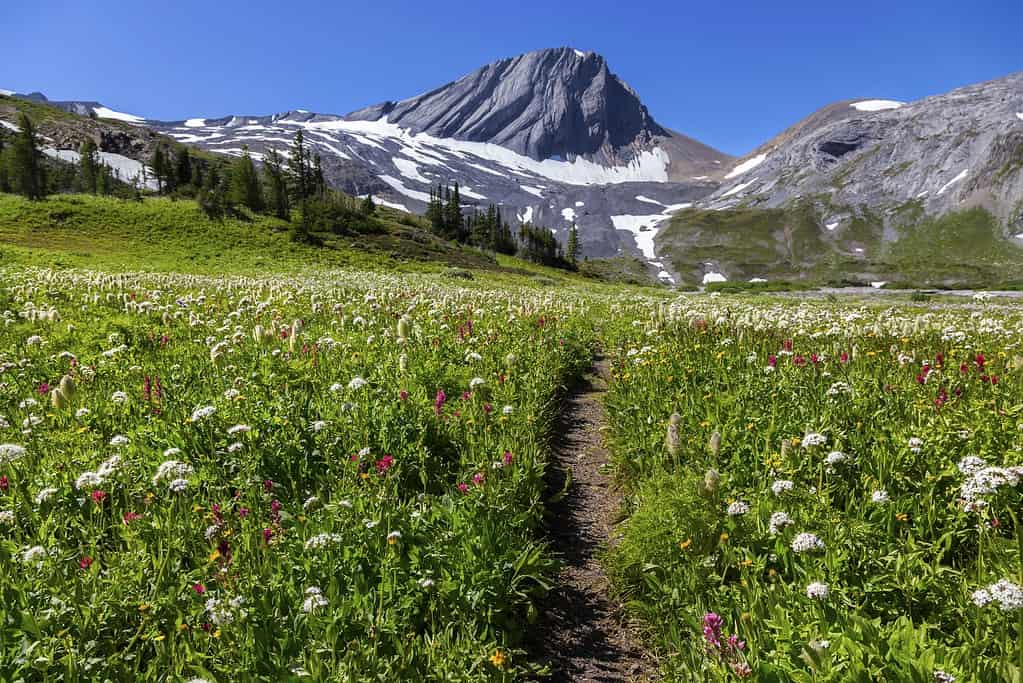While Canada doesn’t have the tallest mountains in the world, some of the peaks there are pretty significant. This country boasts some stunning mountain ranges that can be a boon to visit. Whether you’re a mountain climber or just a nature enthusiast, these mountains can make a once-in-a-lifetime trip.
In this article, we will take a closer look at the tallest mountains in Canada, exploring their rich geological history, cultural significance, and the challenges they pose to those daring enough to ascend their peaks.
1. Mount Logan

This mountain is
thehighest mountain in Canada, though it is only the second-highest in North America.
©Diana Martin-Ioja/Shutterstock.com
Mount Logan is set as a rising sentinal in the Yukon Territory and has the title of Canada’s highest peak – and North America’s second-highest peak. It stands at an impressive 5,959 meters above sea level, making it dominate the surrounding landscape.
Mount Logan is part of the Saint Elias Mountains and, like its neighboring peaks, was formed as a result of the Pacific Plate colliding with the North American Plate. The intense tectonic forces and glacial activity sculpted these mountains over millions of years. Today, they are still some of the tallest on the continent.
Mount Logan presents a daunting task, even for seasoned climbers. With its high altitude, harsh weather, and isolated location, it truly tests one’s abilities and stamina. Ascending to the peak requires thorough preparation and a significant investment of time. Therefore, it is one of the toughest mountains to climb on the continent.
2. Mount Saint Elias

The area around Mount Saint Elias is known for its stunning views.
©iStock.com/bruceman
After Mount Logan, Mount Saint Elias is the nest highest mountain in Canada. It stands at 5,489 meters and is right on the border of Canada and the United States. It’s pretty popular with citizens of both countries for this reason.
Like most mountains in Canada, this one is heavily glaciated. It’s home to the Malaspina Glacier, which is one of the largest glaciers in the world. This adds to the scenic grandeur of the peak and makes it incredibly challenging to climb.
As you might guess, this mountain is named after Saint Elias, who is the patron saint of travelers. It has been a destination of travelers and explorers throughout history, with several expeditions attempting to conquer its summit. Today, it is still exceptionally popular, making it appropriately named.
3. Mount Lucania and King Peak

Both of these mountains are relatively close to each other and are often counted as a “pair” by mountaineers.
©AutumnSkyPhotography/iStock via Getty Images
These two mountains are the third and fourth-highest peaks in Canada. They are both part of the Saint Elias Mountains of the Yukon Territory. They are slightly shorter than the Saint Elias, but they are still commanding in their own right.
Mount Lucania has an elevation of 5,226 meters. It is a formidable peak in its own right. The mountain was named by the Duke of Abruzzi after the RMS Lucania.
King Peak is nearby and stands at 5,173 meters. It’s a majestic summit that many people climb each year. The steep, icy slopes and unpredictable weather make the climb challenging but not nearly as impossible as the other peaks.
4. Mount Waddington
While the previous peaks are part of the Saint Elias Mountains, Mount Waddington belongs to the Coast Mountains of British Columbia. At 4,019 meters, it is the highest peak in this range.
The area is known for its rugged and picturesque terrain. The remote location makes the area around the mountain a very popular vacation spot. Plus, the area is also home to a few pristine glaciers and challenging climbs. Rugged mountaineers have been flocking to the mountain for decades.
This mountain has a special cultural significance for the surrounding indigenous peoples. Its stunning appearance has also landed it in several stories over the years.
The Spirit of the Mountains
Throughout history, these mountains have made a huge impact on Canada and the surrounding populations. They are featured in many Indigenous myths and have found their way into many modern stories, too. Because they are so imposing, it is easy to see why these mountains would play such a huge cultural role in Canada, especially for those who live around them.
Beyond their significant cultural importance, these mountains are also a beacon to travelers and mountain climbers. They are popular destinations for naturalists and mountaineers alike. They make popular adventure destinations, as well as a backdrop to a calming vacation.
Each year, these mountains bring in thousands of people, adding to the tourist revenue of the area. Many businesses and locals around these mountains make much of their income from this tourism every year.
Conservation
Of course, many of these mountains are within local parks and protected areas, helping ensure they are preserved for future generations. Many people want to see these mountains, but steps must be taken to ensure that constant tourism doesn’t harm the ecosystem surrounding them.
For instance, Kluane National Park and Reserve safeguard the towering beauty of Mount Logan. This park helps ensure that the mountain is protected from the effects of tourism as much as possible.
Like mountain ranges worldwide, Canada’s peaks are affected by climate change, with glaciers retreating and ecosystems shifting. Conservation efforts are crucial to mitigate these impacts and safeguard the unique biodiversity of these regions.
Summary of the Tallest Mountains in Canada
| Rank | Mountain | Height (meters) |
|---|---|---|
| 1 | Mount Logan | 5,959 |
| 2 | Mount Saint Elias | 5,489 |
| 3 | Mount Lucania | 5,226 |
| 4 | King Peak | 5,173 |
| 5 | Mount Waddington | 4,019 |
Thank you for reading! Have some feedback for us? Contact the AZ Animals editorial team.








